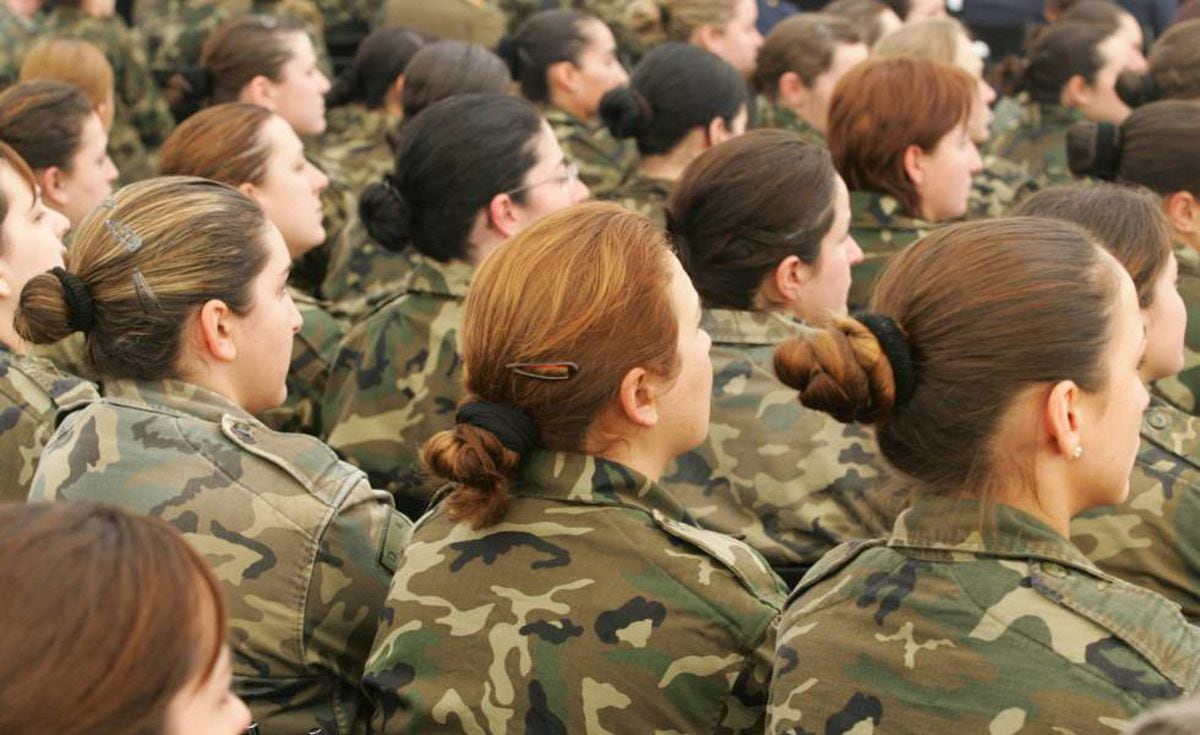Military women during an act at the El Goloso base (Madrid) in December 2019.Uly Martín
Procedures for sexual harassment in the Armed Forces grew by 36% in 2021, when 39 complaints were filed by 46 victims, according to the annual report of the Military Life Observatory.
Specifically, 13 criminal proceedings (three more than in 2020) and 36 disciplinary proceedings (10 more) were processed, giving a total of 49 (one complaint can lead to several files), compared to 36 the previous year.
The largest number of investigations were opened in the Army (33), followed by far by the Air Force (6) and the central body of the Ministry (5).
In recent years, there has been a slight reduction in criminal proceedings (in 2018 and 2019 there were 15 per year), but a constant growth in disciplinary proceedings (13 in 2018 and 23 in 2019), initially less serious.
The document also reflects that all the alleged harassers are male (except one, who has not been identified by the victim);
while 44 of the 46 victims are women.
Of the 53 denounced, 26 are control cadres (officials or non-commissioned officers);
instead, 37 of the victims belong to the rank of troops and sailors, the lowest.
The military courts handed down 13 convictions for crimes of sexual abuse and one for sexual harassment, as well as one acquittal.
Defense has a protocol against sexual harassment and anti-harassment support units (UPAs), which carry out training, awareness and dissemination campaigns in the armies.
The report has been prepared by the Military Life Observatory, a consultative body dependent on the Cortes that studies the living conditions of members of the Armed Forces and presents recommendations.
From December 2018 to June 2021, the Observatory was vacant as Parliament did not elect its members, so this is its first report in the new stage.
The document indicates that the Armed Forces have 16,022 women, 12.90% of the total, a percentage that has remained stable in recent years and is almost one point above the NATO average (12%).
In 2021, 18.6% of the officers and 9.7% of the non-commissioned officers who left the military academies were women.
In total, the number of active-duty soldiers amounted to 118,670 last January 1, which is 11,369 fewer than there were in 2010, when the maximum number was reached.
62% of the troops are part of the Army, while the Air and Navy have 17% each.
The report analyzes the reconciliation measures (flexibility or reduction of the working day) for the care of children or dependents to which the military take refuge in a much higher proportion than their male colleagues (37.1% women, compared to 18.3% of them) and echoes the complaints of the armies, who consider that these measures imply an "overload" of work for the rest of the personnel, can affect the spirit of camaraderie and reduce training.
“After years of experience in the implementation of reconciliation measures, these are beginning to cause those who take advantage of them more harm than benefits.
In addition, the alleged objective of equality is no longer achieved when the rest of the group finds that [...] they enjoy the same privileges without having made the same sacrifice," he says of the Navy.
The Observatory dedicates special attention to the problem of mobility, stressing that in 2021 a total of 26,550 soldiers (22.3% of the total) changed their destination, of which 5,582 (4.7%) did so forcibly, due to which "every four and a half years the equivalent to the total number of troops of all the Armed Forces would be displaced."
Among other problems, the report denounces insufficient financial compensation to meet housing needs and the lack of accommodation in military residences.
Added to this are the difficulties of schooling, for making the transfer outside the period for applying for a place or for going to autonomous communities that teach in a language other than Spanish.
“75% of military personnel have had problems related to schooling in the vehicular language in the Balearic Islands;
61.4% in the Valencian Community, 48.7% in Catalonia;
40% in Navarre;
28.6% in the Basque Country and 22% in Galicia”, says the report.
Among other measures, the Observatory proposes to approve a comprehensive law on the Geographical Mobility of the Armed Forces, pending for years;
exempt from paying personal income tax for financial aid for transfers;
reserve or guarantee school places for the children of military personnel and “assess the establishment of language vehicle exceptions”;
that is to say, that they be exempted from receiving education in a language other than Spanish, especially when they have already been educated in another community.
According to the report, 13 military personnel died while on duty in 2021, three more than in 2020, and 120 were injured, 21 more than the previous year.
During the past year, 22 military merit crosses with a red badge have been awarded, which implies an act of heroism, most of them linked to the evacuation from Afghanistan.
In terms of salaries, the Observatory recommends the creation of a new concept that takes into account the cost of living in the community of residence;
a review of severance pay;
an increase in the special dedication supplement;
and, in general, an update of military salaries "in order to match the salaries of the Armed Forces to those of public employees", especially those of reserve personnel.
Subscribe to continue reading
Read without limits
Keep reading
I'm already a subscriber

